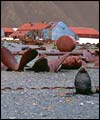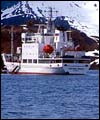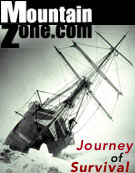In the Footsteps of Sir Ernest Shackleton
Shackleton's Antarctic journey of survival is eclipsed by his trip from oblivion to pop-culture phenomenon
Seattle- August 20, 2002
Pages: 1 2 3 4 5 6
Photos Stromness |
|
"Since our retracing of Shackleton's crossing of South Georgia Island 18 months ago, I've marveled at how Sir Ernest Shackleton has become a figure of popular culture to rival Michael Jackson...." |
An exhibition at New York's Museum of Natural History opened the next year, curated by Alexander herself. It had Hurley's original prints and the actual boat, the James Caird, Shackleton had sailed across the stormiest waters on earth. The museum show was followed by two documentary films made for theaters, one of them shot in IMAX format. Other books began to appear as well, including South With Endurance (Simon & Schuster) a collection of Hurley's photographs, and two books aimed at a business audience that explored the Boss's gift of leadership, Leading at the Edge (Amacom) and Shackleton's Way (Viking).
Shackleton's own book, South, was re-released, and a new biography of Shackleton's trusted seaman, Tom Crean, appeared (Tom Crean, The Mountaineers). Recently, the final two salvos have been let loose: the NOVA program, "Shackleton's Voyage of Endurance," and the A&E miniseries "Shackleton." These programs in a way reflect the maturity of the current cycle of Shackleton mania.
Photos Grigoriy Mikheev |
|
— Peter Potterfield, MountainZone.com Staff
